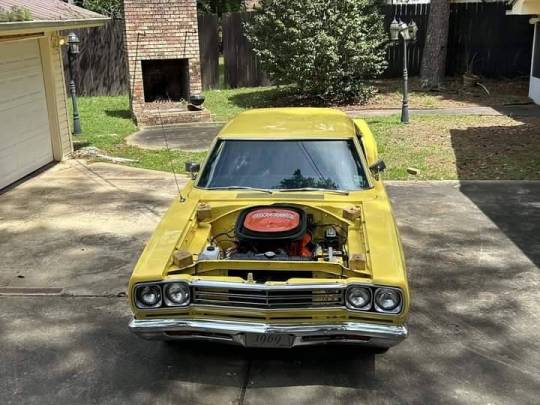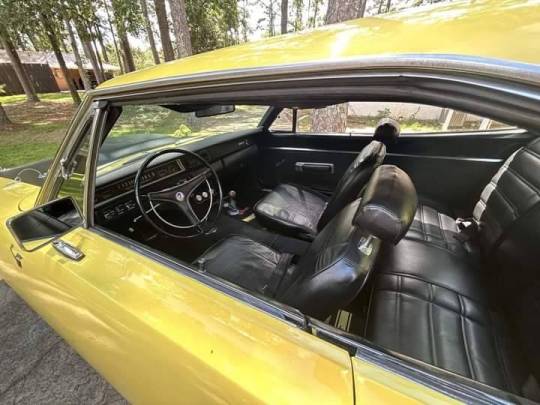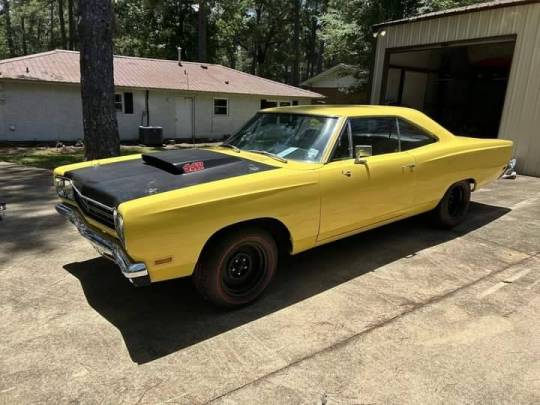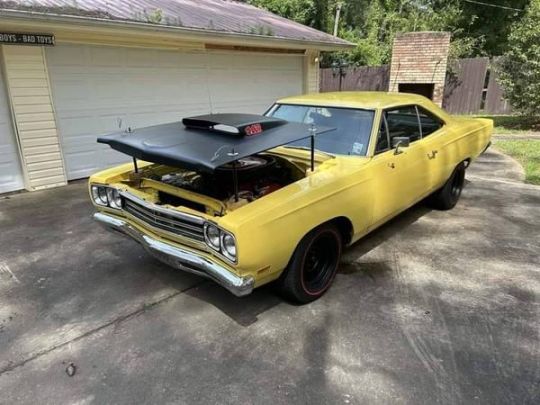Text

1965 Buick Riviera Gran Sport

1965 Buick Riviera Gran Sport

1965 Buick Riviera Gran Sport

1965 Buick Riviera Gran Sport

1965 Buick Riviera Gran Sport

1965 Buick Riviera Gran Sport

1965 Buick Riviera Gran Sport
120 notes
·
View notes
Text

Ford Mustang Shelby GT350
Certainly! Let's analyze the two cars in the image. Top Car: * Make: Ford * Model: Ford Mustang Shelby GT350 * Year: Likely a 1965 or 1966 model. * Color: White with blue stripes. * Modifications: The car appears to be a race car with a roll cage, racing bucket seats, and a modified front end with a large air intake. Bottom Car (Car 2): * Make: Ford * Model: Ford Mustang Shelby GT350 * Year: Likely a 1967 or 1968 model. * Color: Blue with white stripes. * Modifications: The car appears to be mostly original with minimal modifications. Overall: The image shows two classic American muscle cars, the Ford Mustang Shelby GT350, from different years. The top car is a race-prepared version, while the bottom car is a more street-oriented model.
666 notes
·
View notes
Text

1955 Chevy
Documented, authentic, original 1955 Chevy movie car driven by singer James Taylor and Beach Boy Dennis Wilson in the iconic 1971 movie “Two-Lane Blacktop.” This ’55 is one of the three built by Richard Ruth for Universal Studios (two identical straight-axle ’55s and one stunt car) for “Two-Lane Blacktop.”
This car sold at Barrett-Jackson's Scottsdale, AZ, auction for $159,500 on January 17, 2015.
76 notes
·
View notes
Text

1969 Chevrolet Camaro Z28
Details:
1. This specific Z28 is a coupe with the signature dual headlights and a blacked-out grille from the 1969 model year.
2. It's finished in a silver metallic color with black stripes that run along the body and hood.
3. The Z28 designation indicates that this car is equipped with Chevrolet's high-performance 302 cubic inch V8 engine.
4. This engine was a popular choice for racing and delivered impressive power and torque.
5. The Z28 also featured a stiffer suspension, heavy-duty brakes, and a close-ratio 4-speed manual transmission, making it well-suited for performance driving.
6. This particular Camaro appears to be in excellent condition, with its original paint, chrome, and trim all well-maintained.
7. The car sits on a set of classic Rally wheels with Goodyear tires, further enhancing its sporty appearance.
8. Inside, the Z28 likely features a black vinyl interior with a bench seat and a center console.
9. The Z28 is a highly sought-after classic car by collectors and enthusiasts due to its performance heritage and timeless design.
10. This particular example, in its sleek silver metallic finish, is sure to make a statement on the road.
201 notes
·
View notes
Text

1970 Dodge Super Bee
The 1970 Dodge Super Bee is an iconic muscle car that perfectly captures the raw power and aggressive styling of the era. Known for its distinctive "Bee" emblem and bold graphics, the Super Bee features a muscular stance with a wide body and a long hood, designed to make a statement on the road.
Under the hood, it typically offered a range of potent engine options, including the legendary 426 Hemi and the 440-cubic-inch V8, delivering exhilarating performance and speed. The interior is straightforward and focused on the driver, with sporty bucket seats and an available console shifter that enhances the racing feel.
With its combination of performance, style, and attitude, the 1970 Super Bee remains a beloved choice among muscle car enthusiasts and is celebrated for its role in the golden age of American automotive performance.
525 notes
·
View notes
Text

1975 Imperial Le Baron Crown Coupe
The 1975 Imperial Le Baron Crown Coupe is a luxurious American full-size coupe that epitomizes elegance and refinement. Powered by a 440 ci (7.2L) V8 engine producing 215 hp and 345 lb-ft of torque, it features a 3-speed automatic TorqueFlite transmission and rear-wheel drive. With a spacious interior, the Le Baron Crown Coupe boasts luxurious leather or vinyl upholstery, woodgrain trim, power windows, power locks, AM/FM radio with 8-track tape, air conditioning, and cruise control.
Produced in limited numbers, with only 4,127 units made, this vehicle represents the last year of Imperial's separate division status and the final generation of its distinct design language. As one of the largest and most luxurious American coupes of its era, the 1975 Imperial LeBaron Crown Coupe is a rare find, making it highly sought after by collectors and enthusiasts.
31 notes
·
View notes
Text

1956 Continental Mark II

1956 Continental Mark II

1956 Continental Mark II

1956 Continental Mark II
Half of the fun for me in restoring this 1956 Continental Mark II, is finding out more and more about the history of this specific vehicle and connecting the dots and putting all of the pieces of the puzzle together to get a pretty good picture of the owners and whereabouts of where these gems were from the factory to the streets from one owner to the next through different eras, right up to now as it sits in my driveway! For the longest time I was wondering why there was no purchase order for my Mark II, but after recently seeing a production order invoice for my car I can now see why! My specific vehicle was specially made for Leonard K. Firestone of the Firestone Tire and Rubber Company, Leonard was the son of the founder of Firestone, Harvey S. Firestone, the Firestone family were all very close to the Ford family, Leonard’s niece Martha who was the daughter of Harvey Jr. was married to William Clay Ford Jr. and for those of us “Continental Mark II enthusiasts” who have done our homework, we know that William Clay Ford Jr. was the “Ford” that was in charge of and led the way for the seperate Continental division of Ford that made the “Continental Mark II” in 1956 and a short run in 1957, and thus dropped the “Lincoln” from the title during this period, so basically the Ford’s and the Firestones were Family, which is why on all of the 1956-57 Continental Mark II’s they all came equipped with “Firestone Champion Deluxe” tires. Harvey Firestone who was Leonard Firestones Father often vacationed with Henry Ford and Thomas Edison and they referred to themselves as “The Vagabonds” and were recognized as the three leaders in American industry in that era. I find all of this very interesting and it makes it even more of a joy to be restoring a classic beauty with that much history involved with it. A production order two tone paint job made specifically for Leonard Kimball Firestone! I plan on restoring this vehicle back to its original condition and color scheme as much as possible, I love the two tone paint, from what I understand only 68 were ever produced with two tone paint jobs! And this is one of them!
50 notes
·
View notes
Text

𝟏𝟗𝟔𝟗 𝐏𝐥𝐲𝐦𝐨𝐮𝐭𝐡 𝐑𝐨𝐚𝐝 𝐑𝐮𝐧𝐧𝐞𝐫

𝟏𝟗𝟔𝟗 𝐏𝐥𝐲𝐦𝐨𝐮𝐭𝐡 𝐑𝐨𝐚𝐝 𝐑𝐮𝐧𝐧𝐞𝐫

𝟏𝟗𝟔𝟗 𝐏𝐥𝐲𝐦𝐨𝐮𝐭𝐡 𝐑𝐨𝐚𝐝 𝐑𝐮𝐧𝐧𝐞𝐫

𝟏𝟗𝟔𝟗 𝐏𝐥𝐲𝐦𝐨𝐮𝐭𝐡 𝐑𝐨𝐚𝐝 𝐑𝐮𝐧𝐧𝐞𝐫
𝟏𝟗𝟔𝟗 𝐏𝐥𝐲𝐦𝐨𝐮𝐭𝐡 𝐑𝐨𝐚𝐝 𝐑𝐮𝐧𝐧𝐞𝐫 𝐃𝐢𝐭𝐜𝐡𝐞𝐬 𝐅𝐚𝐜𝐭𝐨𝐫𝐲 𝟑𝟖𝟑 𝐕𝟖 𝐟𝐨𝐫 𝐎𝐧𝐞 𝐨𝐟 𝐭𝐡𝐞 𝐁𝐞𝐬𝐭 "𝐒𝐭𝐫𝐞𝐞𝐭 𝐄𝐧𝐠𝐢𝐧𝐞𝐬" 𝐄𝐯𝐞𝐫
This 1969 Plymouth Road Runner hardtop model failed to sell at auction recently with its owner refusing to part with it for just $37,440. The car has undergone two major refurbishments, one in the 1990s and another one more recently in July of this year.
The first-generation Plymouth Road Runner was cool right out of the gate. This was a performance vehicle, which is why all of its original engine options were extremely potent. You had the “entry-level” 383 ci V8 with its 335 horsepower and 425 lb-ft of torque, which as far as base engines go, was no pushover.
Then came the 426 Hemi V8 (chronologically), followed by the so-called 440 Six-Pack (or Six-Barrel) – bigger displacement, less power, same torque; compared to the Hemi. What stood out to most people was that the 440 Six-Pack was more affordable than the Hemi and it excelled in terms of mid-range and torque.
It produced its 490 lb-ft of torque at 3,200 rpm, whereas the Hemi wanted you to push all the way to 4,000 rpm for the same grunt. Now, the 440 unit was officially rated at 390 hp, but a lot of people believe that number to be underrated. It’s worth mentioning.
This particular Road Runner started off with a 383 ci V8 under the hood but would later receive the 440 ci V8 with a trio of two-barrel carburetors. Originally, it had a Limelight Metallic exterior with white longitudinal stripes but was repainted yellow during refurbishment.
Other current visual highlights include the black fiberglass lift-off hood, Road Runner graphics, chrome bumpers, dual side mirrors, chrome exhaust outlets, plus a set of black H-series-style 15” wheels with 235/60 front and 295/50 rear Diamond Back red-line tires.
Moving on to the interior, that’s where you’ll find the black vinyl front bucket seats and rear bench, a color-coordinated dashboard, the Hurst shift
75 notes
·
View notes
Text

1967 Ford Mustang Shelby GT500
Here are a few title options for the image of the Ford Mustang Shelby GT500, considering its year and unique features:
Simple and Informative:
Ford Mustang Shelby GT500 (1967)
A Classic: Ford Mustang Shelby GT500 (1967)— in New York, NY.
Ford Mustang Shelby GT500: A Muscle Car Icon (1967)
Playful and Evocative:
The Beast Unleashed: Ford Mustang Shelby GT500 (1967)
A Slice of American Muscle: Ford Mustang Shelby GT500 (1967)
The Original Track Monster: Ford Mustang Shelby GT500 (1967)
Focusing on the Red Color:
Red Hot Shelby GT500 (1967)
Crimson Crush: Ford Mustang Shelby GT500 (1967)
You can also combine elements from different options to create your own unique title.
Example:
"Ford Mustang Shelby GT500 (1967): The Red Hot American Muscle Car"
Feel free to adjust the tone and style to fit your preferences and the context where you'll be using the image.
64 notes
·
View notes






